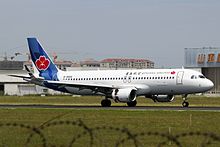Qingdao Airlines is a startup Chinese airline that commenced operations on 26 April 2014. The carrier is based at Qingdao Jiaodong International Airport.[1]
 | |||||||
| |||||||
| Founded | June 2013 | ||||||
|---|---|---|---|---|---|---|---|
| Commenced operations | 26 April 2014 | ||||||
| Operating bases | |||||||
| Fleet size | 40 | ||||||
| Destinations | 24 | ||||||
| Parent company | Nanshan Group (100%) | ||||||
| Headquarters | Chengyang District, Qingdao, Shandong | ||||||
| Key people |
| ||||||
| Website | www | ||||||
| Qingdao Airlines | |||||||
|---|---|---|---|---|---|---|---|
| Simplified Chinese | 青岛航空 | ||||||
| Traditional Chinese | 青島航空 | ||||||
| |||||||
History edit
An application for the establishment of an airline based in the Shandong province was filed with the Civil Aviation Administration of China (CAAC) by the Yantai-based Nanshan Group in May 2013.[2] Approval was received by the CAAC between that month and June 2013,[3] when Qingdao Airlines was formed.[4]
Corporate affairs edit
Ownership edit
Initially, the airline was owned by the Nanshan Group (55%), the Qingdao Transport Development Group (QTDG) (25%) and Shandong Airlines (20%). The initial capital of Qingdao Airlines was CNY1 billion (USD161 million).[4] In July 2015, Shandong Airlines transferred its shares to a subsidiary of the Nanshan Group; as of August 2015[update], the airline plans to sell the 25% of the shares held by QTDG in order to become fully private.[5] Since November 2015, Qingdao Airlines was fully owned by Nanshan Group.[6]
Key people edit
As of April 2014[update], Song Zuowen was the president of the airline.[7]
Headquarters edit
The airline's headquarters are in Chengyang District, Qingdao.[8]
Destinations edit
Operations started on 26 April 2014 linking Qingdao with Chengdu.[4] As of May 2014[update], the airline's top five routes ranked by seat capacity were Qingdao–Shanghai, Qingdao–Beijing, Qingdao–Hangzhou, Qingdao–Shenyang and Qingdao–Dalian.[9] As of October 2016[update], Qingdao Airlines served the following destinations:[10]
Qingdao Airlines operates to the following destinations (as of July 2019):[citation needed]
The airline originally aimed to become a ″boutique airline″ and had plans to start services to Shenzhen and Shenyang in the near future; Guangzhou and Shanghai were expected to be served in the longer term.[4]
Fleet edit

As of May 2023[update], Qingdao Airlines fleet consists of the following aircraft:[15]
| Aircraft | In service | Orders |
|---|---|---|
| Airbus A320-200 | 14 | 0 |
| Airbus A320neo | 23 | 0 |
| Airbus A321neo | 3 | 0 |
| Total | 40 | 0 |
In September 2013, an order for five Airbus A320s and 18 A320neos was placed in a deal valued at USD2.5 billion.[16] The carrier phased in its first aircraft, a 152-seater Airbus A320, in early April 2014.[17][18] The carrier took ownership of its first two A320neos in October 2018.[19] Qingdao Airlines planned to expand its fleet to 60 aircraft by 2020.[5]
References edit

External links edit
- Qingdao Airlines (in Chinese)